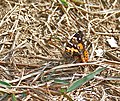Vanessa indica: Difference between revisions
m Changing the font of the title to italics |
Nilupulcool (talk | contribs) No edit summary |
||
| Line 42: | Line 42: | ||
==External links== |
==External links== |
||
*[http://www.wildreach.com/butterflies/Vanessa_indica.php Sri Lanka Wild Life Information Database] |
|||
{{commonscat}} |
{{commonscat}} |
||
* http://www.funet.fi/pub/sci/bio/life/insecta/lepidoptera/ditrysia/papilionoidea/nymphalidae/nymphalinae/vanessa/ |
* http://www.funet.fi/pub/sci/bio/life/insecta/lepidoptera/ditrysia/papilionoidea/nymphalidae/nymphalinae/vanessa/ |
||
Revision as of 09:01, 10 December 2010
| Indian Red Admiral | |
|---|---|

| |
| Scientific classification | |
| Kingdom: | |
| Phylum: | |
| Class: | |
| Order: | |
| Family: | |
| Subfamily: | |
| Tribe: | |
| Genus: | |
| Subgenus: | |
| Species: | V. indica
|
| Binomial name | |
| Vanessa indica (Herbst, 1794)
| |
Vanessa indica, called the Asian Admiral in the United States and the Indian Red Admiral elsewhere, is a butterfly found in the higher altitude regions of India. It is a close relative of the Painted Lady.
Description

Resembles Vanessa cardui but the ground-colour is darker both on the upper and under sides, and the orange markings deeper and richer in tint. Differs also as follows:—Underside fore wing: the ochraceous orange-red on disc, and across cell proportionately of less extent, and uniform, not getting paler towards apex of cell; the upper four spots of the prcapical transverse series on the black apical area minute. it is about 5 inches in length. Hind wing : the postdiscal transverse band much narrower and shorter, not extending below vein 1, margined inwardly by a series of broad black subcrescentic marks ; the tornal angle with a small patch of violet scales bordered inwardly by a short black transverse line. Underside very much darker than in V. cardui, the orange-red on disc and in cell on fore wing restricted as on the upperside ; three small transversely placed blue spots beyond the cell. Hind wing: the mottling comparatively very dark, purplish blade, with slender white margins, shaded on disc with rich dark olive-brown ; the postdiscal series of ocelli dark and somewhat obscure; an inner subtei-minal transverse series of blue, and an outer very much slenderer transverse series of black lunules. Cilia of both fore and hind wings white, alternated with brown. Antenna) black, tipped with pale ochraceous ; head, thorax and abdomen with dark olive-brown pubescence ; beneath, the palpi, thorax and abdomen pale ochraceous brown.[1] t
Range
V. indica is found in the higher altitude regions (above 2000 feet[1]) of India including the Nilgiri Hills in southern India. It also occurs on smaller hill ranges in Peninsular India such as the Nandi hills near Bangalore.
Larva
The larvae of V. indica are known to feed on:
- Urtica (nettles)
- Urtica thunbergiana
- Girardinia heterophylla (Himalayan nettle)
- Boehmeria densiflora
- Boehmeria nivea (Ramie)
Cultural references
- In March 1987 DPR Korea issued a postage stamp depicting Vanessa indica.
References
External links
- http://www.funet.fi/pub/sci/bio/life/insecta/lepidoptera/ditrysia/papilionoidea/nymphalidae/nymphalinae/vanessa/
- Kunte, K. 2010. Vanessa indica Herbst, 1794 – Indian Red Admiral. In, K. Kunte, U. Kodandaramaiah & Kalesh S. (eds.). Butterflies of India. v.1.0. accessed on 28 Feb 2010.




